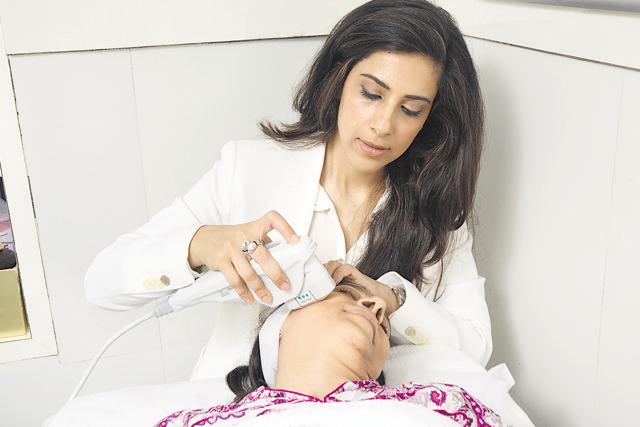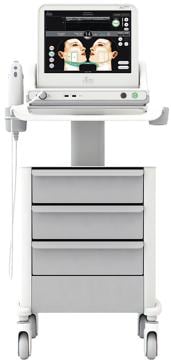Ultherapy: Banish signs of ageing without creams, fillers or toxins
A cosmetology treatment that uses ultrasound waves claims to counter the effects of time and gravity on your skin. We get experts to give you the low-down.
The gift bag, worth $22,000, that was presented to the celebrities at the Grammys, and the $2,00,000-worth goodie bag that was handed out to those who attended the Oscars, had one item in common — a gift coupon for a session of ‘Ultherapy’. This non-surgical, FDA-approved ultrasound treatment claims to counter the effects that time and gravity have on a person’s skin. Needless to say, the treatment is fast gaining popularity around the world.

However, Ultherapy is not the actual name of this therapy, explains city-based dermatologist and laser surgeon Dr Apratim Goel. “Ulthera is the name of a machine, and another similar machine is called Ultraformer. The technology involved in both is HIFU (High Intensity Focussed Ultrasound). So, it is essentially HIFU treatment. Ultherapy is a company name that has gained a lot of popularity in the US and has become synonymous with HIFU treatment,” she says.
In this therapy, the ultrasound apparently stimulates collagen production in the skin, resulting in a clinically significant lift of tissue over a period of two to three months. The procedure deposits focused ultrasound energy deep beneath the skin at the optimal temperature for collagen regeneration; this jump-starts a natural process known as neocollagenesis, and leads to the production of fresh, new collagen. “Unlike other therapies, this doesn’t involve any creams, fillers or toxins. It just relies on the body’s own collagen-building process for natural, noticeable results,” says cosmetologist Dr Monica Jacob, adding that this treatment has found many takers in the city.
What steps does this treatment involve?
1. The treatment consists of first assessing the areas of the face and neck that need tightening. Ideally, the deep as well as superficial layer of the skin needs to be tightened to achieve the best outcome.
2. The areas are then cleansed with a degreasing substance. Ultrasound gel is applied to the area, and the skin thickness is assessed for each area.
3. The areas and the energy to be delivered are marked. The appropriate probe (the head of the machine through which the ultrasound energy is delivered; there are a variety of such heads for different parts of the skin) is taken for the specific area.
4. There are different probes used, depending on the thickness of the skin, which varies from 2.5mm to 4.5mm. The 4.5mm probe is used to deliver focussed ultrasound energy to the area on the cheeks so as to tighten the deeper layer, called the SMAS layer. The 3.5mm probe is then used to tighten the skin on the forehead, around the eyes, neck and décolletage (lower neck and upper chest area).
5. The number of energy shots to an area are pre-calculated (it depends on the thickness of the skin and the degree of ageing), so as to not deliver extra energy, thus preventing any problems.

Who should opt for it?
1. Those who are bothered by loose, sagging skin around the neck and jowl, or those who have a double chin, usually choose this form of therapy. However, the best candidates for HIFU are those who have lost lots of weight and now want to get rid of the dull and sagging skin.
2. This treatment is recommended to middle-aged people who are concerned about early signs of ageing, to reduce lines and wrinkles.
3. It can also benefit people who have medical diseases and are not fit for surgical facelifts.
What are its benefits?
1. The treatment mostly involves a single session of approximately 30-40 minutes There is no downtime associated with this procedure; people can get back to work as soon as the treatment is over. Hence, this procedure is also called a ‘lunch-time procedure’.
2. It works on sound waves. Therefore, it is considered safe for diabetics and those suffering from immune problems.
3. It is non-surgical, and gives minimal discomfort with results that are comparable to surgery.
Stay away if you…
1. Have open wounds and other diseases in the treatment area
2. Have severe or cystic acne in the treatment area
3. Have active implants (pacemakers or defibrillators), or metallic implants in the treatment area
4. Are on blood thinners or have a bleeding tendency, have herpes, or fits, or have had facial paralysis
4. Are pregnant or nursing a child
5. Are very young or suffering from acne
6. Have excessive sun damage or laxity of skin.
(With inputs from Dr Mohan Thomas, cosmetic surgeon, Dr Harshna Bijlani, cosmetologist, and Dr Soma Sarkar, dermatologist)

Are there any side effects?
Redness: The treated area may exhibit some redness immediately following the treatment. This typically is resolved within a few hours.
Swelling: The treated area may exhibit mild swelling, which tends to go away within three to 72 hours of the treatment.
Pain: Momentary discomfort may be experienced during the procedure.
Bruising: Mild bruising may occur occasionally, but it is typically resolved within two days to a week of the treatment.
Nerve effects: It can temporarily weaken the muscles around the face due to a swelling around a nerve. There can also be temporary numbness if the nerve is seriously swollen. This improves within two to six weeks after the treatment.
Adults only
There is no minimum age limit for this treatment as it is non-invasive, but the procedure is given only to adults. It is important that the patient understands the implications of the procedure, including the possible outcomes, before opting for it.
Catch your daily dose of Fashion, Taylor Swift, Health, Festivals, Travel, Relationship, Recipe and all the other Latest Lifestyle News on Hindustan Times Website and APPs.
Catch your daily dose of Fashion, Taylor Swift, Health, Festivals, Travel, Relationship, Recipe and all the other Latest Lifestyle News on Hindustan Times Website and APPs.





